Adidas Marketing Analysis: Market Structure, Competition, and Trends
VerifiedAdded on 2023/01/07
|13
|3347
|1
Report
AI Summary
This report provides a comprehensive marketing analysis of Adidas, focusing on its market structure and its transformation over time. It begins with an overview of Adidas, including its history, products, and services. The report then delves into Adidas's current market structure, identifying it as an oligopoly, and discusses the characteristics of this market, such as non-price competition and interdependent decision-making. It examines the transformation of Adidas's market structure from monopolistic competition to an oligopoly, analyzing the factors that led to this shift, including increasing demand and challenges related to excess capacity. The report also explores the competitive landscape, highlighting Adidas's major competitors like Nike and Puma, and discusses strategies for maintaining a competitive advantage. Finally, the report touches upon the potential impact of government intervention on Adidas's market position, with the aim of providing a holistic understanding of Adidas's marketing environment. Desklib offers similar solved assignments for students.
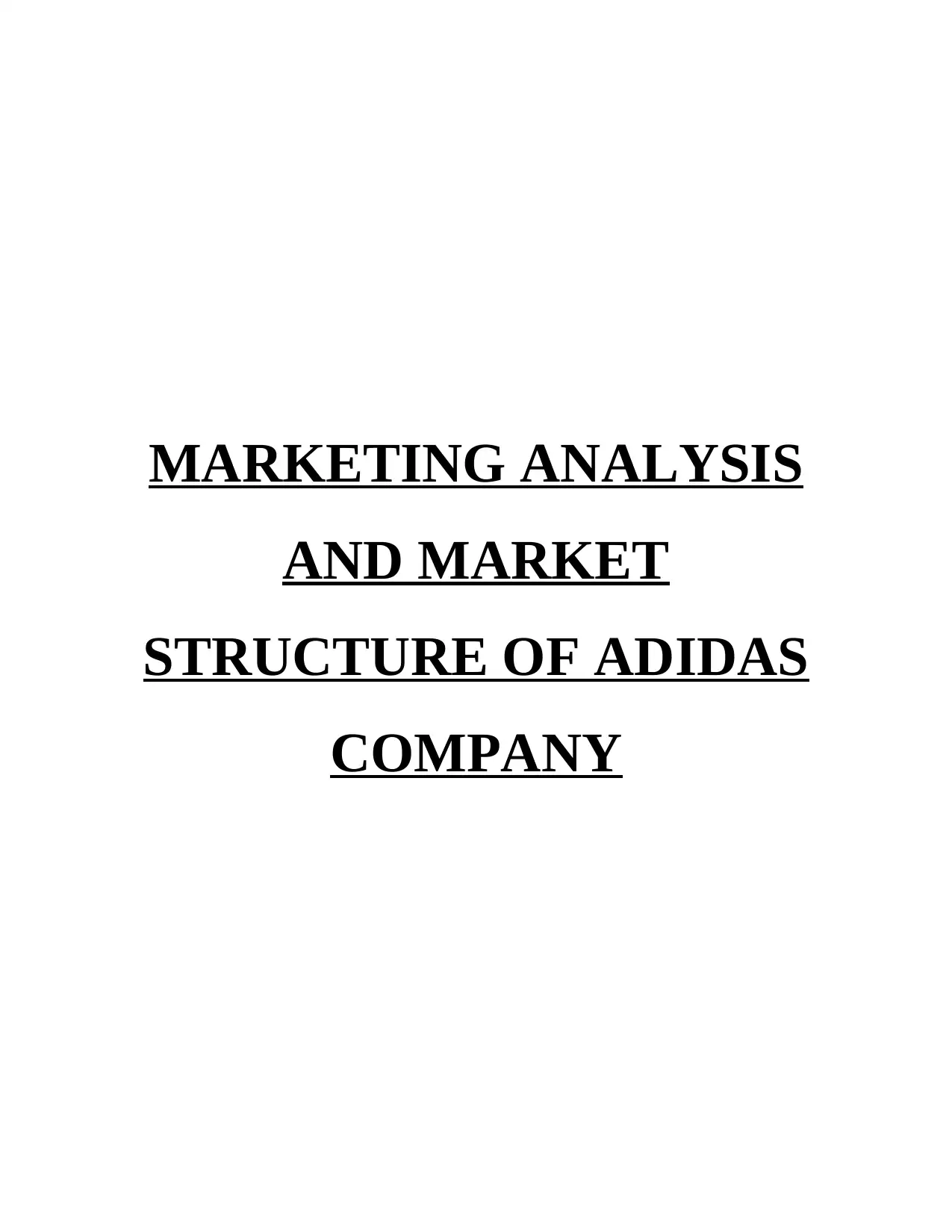
MARKETING ANALYSIS
AND MARKET
STRUCTURE OF ADIDAS
COMPANY
AND MARKET
STRUCTURE OF ADIDAS
COMPANY
Paraphrase This Document
Need a fresh take? Get an instant paraphrase of this document with our AI Paraphraser

TABLE OF CONTENTS
INTRODUCTION...........................................................................................................................3
Organisation and its overview.....................................................................................................3
Current Market structure of Adidas.............................................................................................4
Transformation and characteristics of Market structure of Adidas.............................................6
Analysing the Market structure.................................................................................................10
Government Intervention – Good or Bad..................................................................................11
CONCLUSION..............................................................................................................................12
REFERENCES..............................................................................................................................13
INTRODUCTION...........................................................................................................................3
Organisation and its overview.....................................................................................................3
Current Market structure of Adidas.............................................................................................4
Transformation and characteristics of Market structure of Adidas.............................................6
Analysing the Market structure.................................................................................................10
Government Intervention – Good or Bad..................................................................................11
CONCLUSION..............................................................................................................................12
REFERENCES..............................................................................................................................13

INTRODUCTION
Market Analysis is the most significant process to be done by the companies that are newly
started and the established companies who want to expand itself in other countries. In this the
market structure plays a major role because it evaluates the way the business can be structured
according to the characteristics of the market in terms of buyers and sellers and their relationship.
Adidas, being a multinational corporation, deals in designing and manufacturing of shoes,
accessories and clothing has its headquarter in Germany. It is the largest manufacturer of
sportswear in Europe and second largest in World.
The report below will describe the history of the company Adidas along with its products and
services. It will also evaluate the type of market in which Adidas is operating since years by
focusing on the previous market structure. It will finally suggest that the company should adapt
different market structure or not along with the impact of the government intervention.
Organisation and its overview
Adidas is world known accessories and apparel industry with headquarter in Germany. Its
key products and services include manufacturing of clothing, accessories and shoes. The
sportswear and shoes of the company are known to be its unique selling products.
History: Organisation was founded by Adolf Adi Dassler. In the initial days of organisational
development, he used to develop spiked running shoes for the athletic events. From initial days
as well a greater emphasis has been laid on quality of products. When US sprinter Jesse Owens
won gold medals with the Adidas made handmade spike then it gains immense popularity and
faith from the people. In 1947 Dassler brothers separated and Rudolf formed a firm known as
Puma at present and Dassler formed formally registered firm Adidas.
Products and services: Organisation provides clothing range for both women and men such as
pants, leggings, jackets, hoodies and t shirts. In addition to the sportswear Adidas also focuses on
associated game kits and equipments for football and other games. Organisation always tries to
bring innovative and comfortable foot wear for sports. With the beginning of 2000s along with
the sports performance organisation also initiated to introduce new and creative lifestyle
segments emphasising on sports inspired street wear (History, 2020). In 2006 an additional
milestone was added to success of company when Adidas acquired Reebok and thus providing
the best sporting good services from the leading service provides of the world. In order to gain
3
Market Analysis is the most significant process to be done by the companies that are newly
started and the established companies who want to expand itself in other countries. In this the
market structure plays a major role because it evaluates the way the business can be structured
according to the characteristics of the market in terms of buyers and sellers and their relationship.
Adidas, being a multinational corporation, deals in designing and manufacturing of shoes,
accessories and clothing has its headquarter in Germany. It is the largest manufacturer of
sportswear in Europe and second largest in World.
The report below will describe the history of the company Adidas along with its products and
services. It will also evaluate the type of market in which Adidas is operating since years by
focusing on the previous market structure. It will finally suggest that the company should adapt
different market structure or not along with the impact of the government intervention.
Organisation and its overview
Adidas is world known accessories and apparel industry with headquarter in Germany. Its
key products and services include manufacturing of clothing, accessories and shoes. The
sportswear and shoes of the company are known to be its unique selling products.
History: Organisation was founded by Adolf Adi Dassler. In the initial days of organisational
development, he used to develop spiked running shoes for the athletic events. From initial days
as well a greater emphasis has been laid on quality of products. When US sprinter Jesse Owens
won gold medals with the Adidas made handmade spike then it gains immense popularity and
faith from the people. In 1947 Dassler brothers separated and Rudolf formed a firm known as
Puma at present and Dassler formed formally registered firm Adidas.
Products and services: Organisation provides clothing range for both women and men such as
pants, leggings, jackets, hoodies and t shirts. In addition to the sportswear Adidas also focuses on
associated game kits and equipments for football and other games. Organisation always tries to
bring innovative and comfortable foot wear for sports. With the beginning of 2000s along with
the sports performance organisation also initiated to introduce new and creative lifestyle
segments emphasising on sports inspired street wear (History, 2020). In 2006 an additional
milestone was added to success of company when Adidas acquired Reebok and thus providing
the best sporting good services from the leading service provides of the world. In order to gain
3
⊘ This is a preview!⊘
Do you want full access?
Subscribe today to unlock all pages.

Trusted by 1+ million students worldwide

competitive success company is also trying to integrate digital technology for making its brand
fast and as an open source platform for athlete and consumers for partnership with company.
Current Market structure of Adidas
Adidas is one of the leaders in sportswear production across globe including sport shoes,
clothing and accessories etc. It is the top producers in Europe and second largest worldwide after
Nike. Adidas is a multinational corporation, founded and headquartered in Herzogenaurach,
Germany. The Adidas group consists of Reebok, Runtastic and TaylorMade. Some of Adidas'
major competitors are Nike, Under Armour and Puma. Currently, Adidas operates in a
oligopolistic market structure. An Oligopoly is that form of market structure in which few
companies dominate the specific industry and share very similar product rages with huge amount
of investment. Such companies completely control and lead the market share of that industry.
Adidas and its rival Nike currently control more than 60% of the market share of sportswear
clothing and footwear industry. Other companies that are operating in the industry are Puma,
under amour, new balance, Sketchers, Asics, Lululemon etc.
Figure 1: Market Share of Adidas
Source: Jacob Sonenshine, 2018, Wedbush securities Estimates
4
fast and as an open source platform for athlete and consumers for partnership with company.
Current Market structure of Adidas
Adidas is one of the leaders in sportswear production across globe including sport shoes,
clothing and accessories etc. It is the top producers in Europe and second largest worldwide after
Nike. Adidas is a multinational corporation, founded and headquartered in Herzogenaurach,
Germany. The Adidas group consists of Reebok, Runtastic and TaylorMade. Some of Adidas'
major competitors are Nike, Under Armour and Puma. Currently, Adidas operates in a
oligopolistic market structure. An Oligopoly is that form of market structure in which few
companies dominate the specific industry and share very similar product rages with huge amount
of investment. Such companies completely control and lead the market share of that industry.
Adidas and its rival Nike currently control more than 60% of the market share of sportswear
clothing and footwear industry. Other companies that are operating in the industry are Puma,
under amour, new balance, Sketchers, Asics, Lululemon etc.
Figure 1: Market Share of Adidas
Source: Jacob Sonenshine, 2018, Wedbush securities Estimates
4
Paraphrase This Document
Need a fresh take? Get an instant paraphrase of this document with our AI Paraphraser
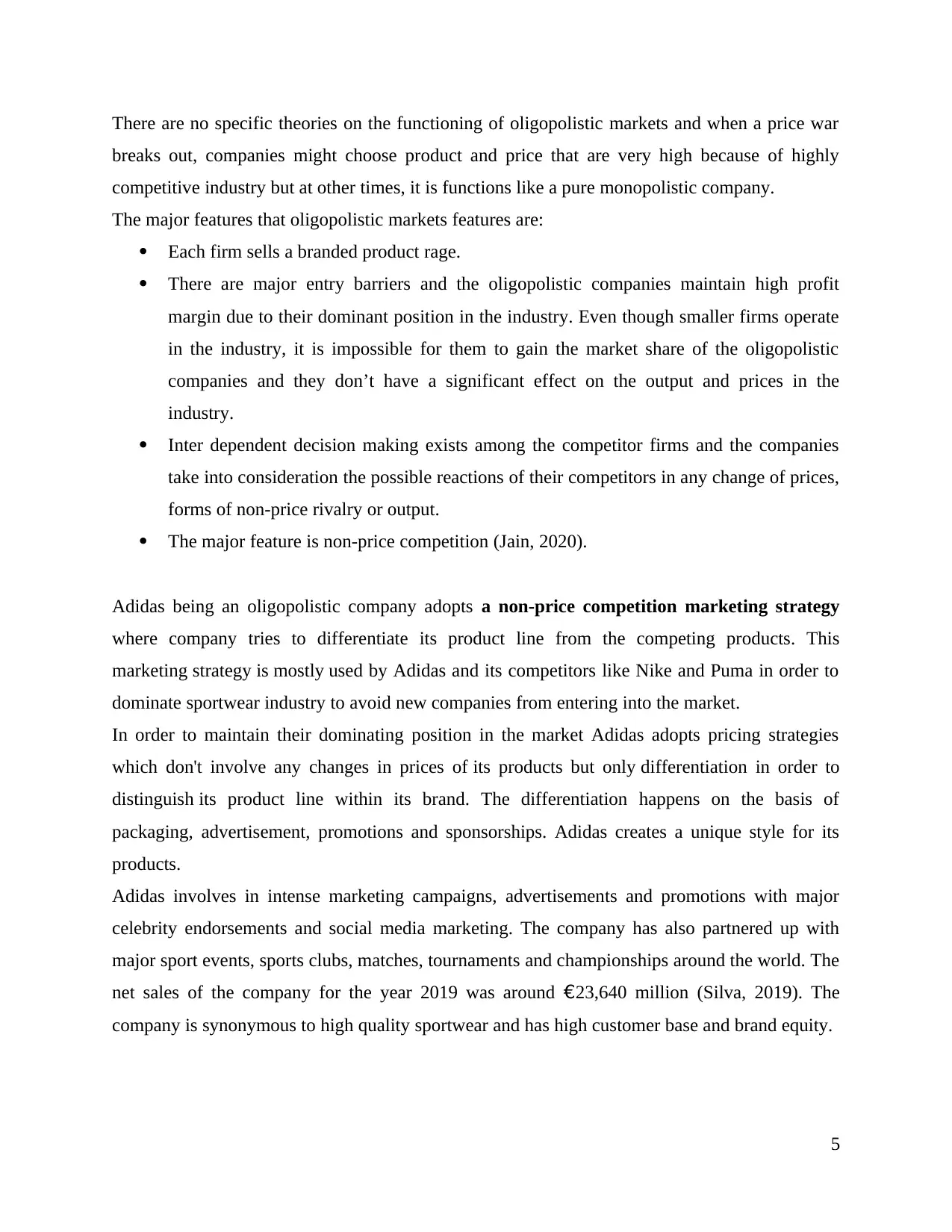
There are no specific theories on the functioning of oligopolistic markets and when a price war
breaks out, companies might choose product and price that are very high because of highly
competitive industry but at other times, it is functions like a pure monopolistic company.
The major features that oligopolistic markets features are:
Each firm sells a branded product rage.
There are major entry barriers and the oligopolistic companies maintain high profit
margin due to their dominant position in the industry. Even though smaller firms operate
in the industry, it is impossible for them to gain the market share of the oligopolistic
companies and they don’t have a significant effect on the output and prices in the
industry.
Inter dependent decision making exists among the competitor firms and the companies
take into consideration the possible reactions of their competitors in any change of prices,
forms of non-price rivalry or output.
The major feature is non-price competition (Jain, 2020).
Adidas being an oligopolistic company adopts a non-price competition marketing strategy
where company tries to differentiate its product line from the competing products. This
marketing strategy is mostly used by Adidas and its competitors like Nike and Puma in order to
dominate sportwear industry to avoid new companies from entering into the market.
In order to maintain their dominating position in the market Adidas adopts pricing strategies
which don't involve any changes in prices of its products but only differentiation in order to
distinguish its product line within its brand. The differentiation happens on the basis of
packaging, advertisement, promotions and sponsorships. Adidas creates a unique style for its
products.
Adidas involves in intense marketing campaigns, advertisements and promotions with major
celebrity endorsements and social media marketing. The company has also partnered up with
major sport events, sports clubs, matches, tournaments and championships around the world. The
net sales of the company for the year 2019 was around €23,640 million (Silva, 2019). The
company is synonymous to high quality sportwear and has high customer base and brand equity.
5
breaks out, companies might choose product and price that are very high because of highly
competitive industry but at other times, it is functions like a pure monopolistic company.
The major features that oligopolistic markets features are:
Each firm sells a branded product rage.
There are major entry barriers and the oligopolistic companies maintain high profit
margin due to their dominant position in the industry. Even though smaller firms operate
in the industry, it is impossible for them to gain the market share of the oligopolistic
companies and they don’t have a significant effect on the output and prices in the
industry.
Inter dependent decision making exists among the competitor firms and the companies
take into consideration the possible reactions of their competitors in any change of prices,
forms of non-price rivalry or output.
The major feature is non-price competition (Jain, 2020).
Adidas being an oligopolistic company adopts a non-price competition marketing strategy
where company tries to differentiate its product line from the competing products. This
marketing strategy is mostly used by Adidas and its competitors like Nike and Puma in order to
dominate sportwear industry to avoid new companies from entering into the market.
In order to maintain their dominating position in the market Adidas adopts pricing strategies
which don't involve any changes in prices of its products but only differentiation in order to
distinguish its product line within its brand. The differentiation happens on the basis of
packaging, advertisement, promotions and sponsorships. Adidas creates a unique style for its
products.
Adidas involves in intense marketing campaigns, advertisements and promotions with major
celebrity endorsements and social media marketing. The company has also partnered up with
major sport events, sports clubs, matches, tournaments and championships around the world. The
net sales of the company for the year 2019 was around €23,640 million (Silva, 2019). The
company is synonymous to high quality sportwear and has high customer base and brand equity.
5
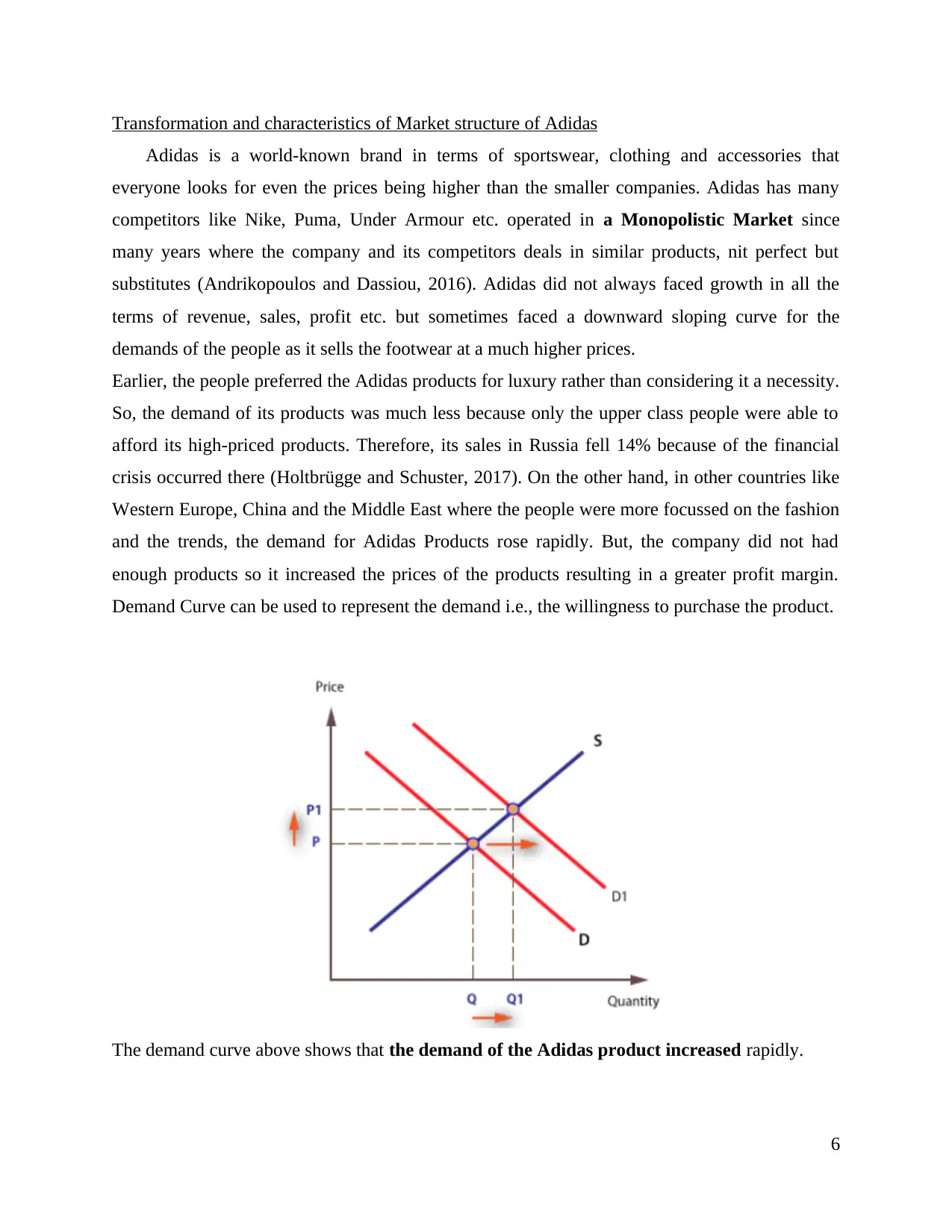
Transformation and characteristics of Market structure of Adidas
Adidas is a world-known brand in terms of sportswear, clothing and accessories that
everyone looks for even the prices being higher than the smaller companies. Adidas has many
competitors like Nike, Puma, Under Armour etc. operated in a Monopolistic Market since
many years where the company and its competitors deals in similar products, nit perfect but
substitutes (Andrikopoulos and Dassiou, 2016). Adidas did not always faced growth in all the
terms of revenue, sales, profit etc. but sometimes faced a downward sloping curve for the
demands of the people as it sells the footwear at a much higher prices.
Earlier, the people preferred the Adidas products for luxury rather than considering it a necessity.
So, the demand of its products was much less because only the upper class people were able to
afford its high-priced products. Therefore, its sales in Russia fell 14% because of the financial
crisis occurred there (Holtbrügge and Schuster, 2017). On the other hand, in other countries like
Western Europe, China and the Middle East where the people were more focussed on the fashion
and the trends, the demand for Adidas Products rose rapidly. But, the company did not had
enough products so it increased the prices of the products resulting in a greater profit margin.
Demand Curve can be used to represent the demand i.e., the willingness to purchase the product.
The demand curve above shows that the demand of the Adidas product increased rapidly.
6
Adidas is a world-known brand in terms of sportswear, clothing and accessories that
everyone looks for even the prices being higher than the smaller companies. Adidas has many
competitors like Nike, Puma, Under Armour etc. operated in a Monopolistic Market since
many years where the company and its competitors deals in similar products, nit perfect but
substitutes (Andrikopoulos and Dassiou, 2016). Adidas did not always faced growth in all the
terms of revenue, sales, profit etc. but sometimes faced a downward sloping curve for the
demands of the people as it sells the footwear at a much higher prices.
Earlier, the people preferred the Adidas products for luxury rather than considering it a necessity.
So, the demand of its products was much less because only the upper class people were able to
afford its high-priced products. Therefore, its sales in Russia fell 14% because of the financial
crisis occurred there (Holtbrügge and Schuster, 2017). On the other hand, in other countries like
Western Europe, China and the Middle East where the people were more focussed on the fashion
and the trends, the demand for Adidas Products rose rapidly. But, the company did not had
enough products so it increased the prices of the products resulting in a greater profit margin.
Demand Curve can be used to represent the demand i.e., the willingness to purchase the product.
The demand curve above shows that the demand of the Adidas product increased rapidly.
6
⊘ This is a preview!⊘
Do you want full access?
Subscribe today to unlock all pages.

Trusted by 1+ million students worldwide
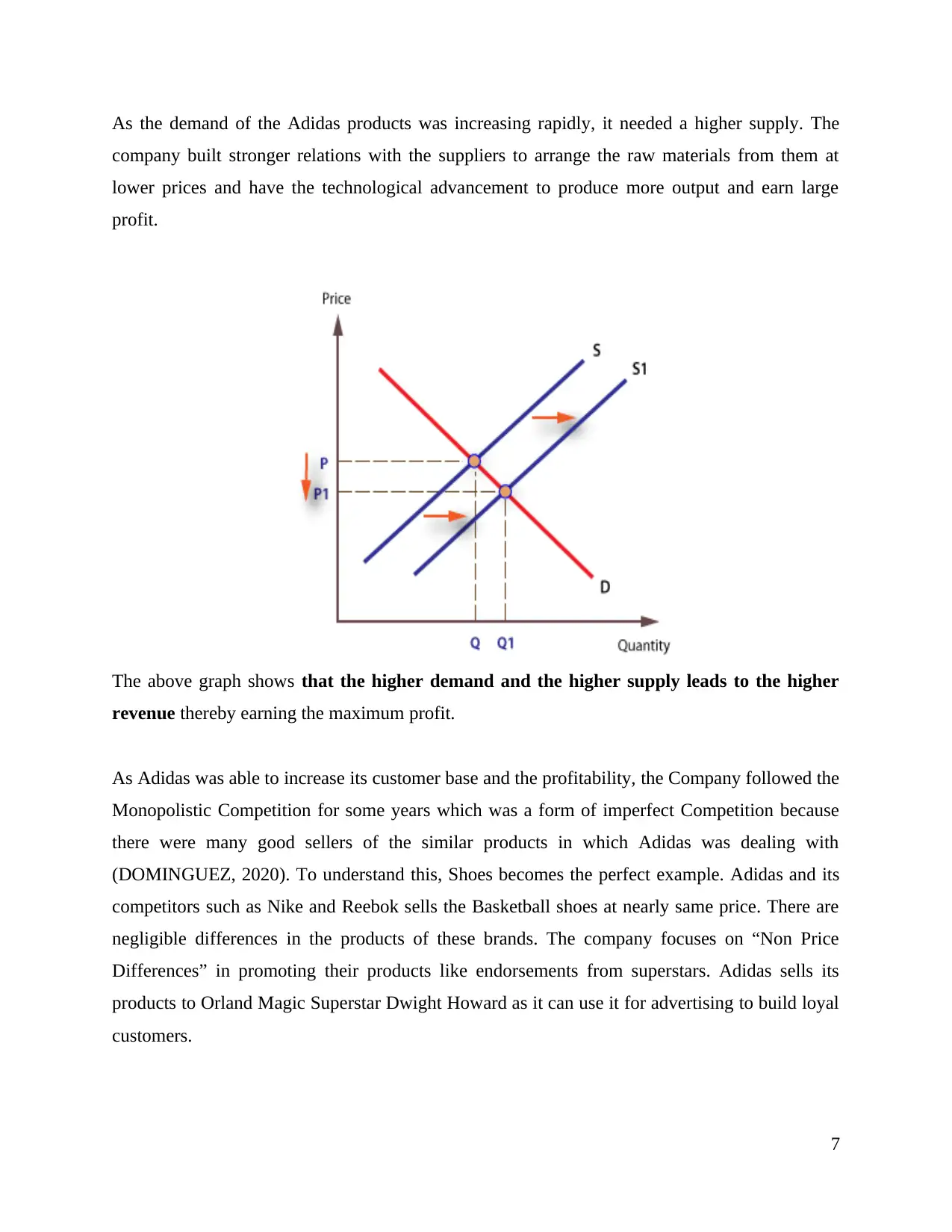
As the demand of the Adidas products was increasing rapidly, it needed a higher supply. The
company built stronger relations with the suppliers to arrange the raw materials from them at
lower prices and have the technological advancement to produce more output and earn large
profit.
The above graph shows that the higher demand and the higher supply leads to the higher
revenue thereby earning the maximum profit.
As Adidas was able to increase its customer base and the profitability, the Company followed the
Monopolistic Competition for some years which was a form of imperfect Competition because
there were many good sellers of the similar products in which Adidas was dealing with
(DOMINGUEZ, 2020). To understand this, Shoes becomes the perfect example. Adidas and its
competitors such as Nike and Reebok sells the Basketball shoes at nearly same price. There are
negligible differences in the products of these brands. The company focuses on “Non Price
Differences” in promoting their products like endorsements from superstars. Adidas sells its
products to Orland Magic Superstar Dwight Howard as it can use it for advertising to build loyal
customers.
7
company built stronger relations with the suppliers to arrange the raw materials from them at
lower prices and have the technological advancement to produce more output and earn large
profit.
The above graph shows that the higher demand and the higher supply leads to the higher
revenue thereby earning the maximum profit.
As Adidas was able to increase its customer base and the profitability, the Company followed the
Monopolistic Competition for some years which was a form of imperfect Competition because
there were many good sellers of the similar products in which Adidas was dealing with
(DOMINGUEZ, 2020). To understand this, Shoes becomes the perfect example. Adidas and its
competitors such as Nike and Reebok sells the Basketball shoes at nearly same price. There are
negligible differences in the products of these brands. The company focuses on “Non Price
Differences” in promoting their products like endorsements from superstars. Adidas sells its
products to Orland Magic Superstar Dwight Howard as it can use it for advertising to build loyal
customers.
7
Paraphrase This Document
Need a fresh take? Get an instant paraphrase of this document with our AI Paraphraser
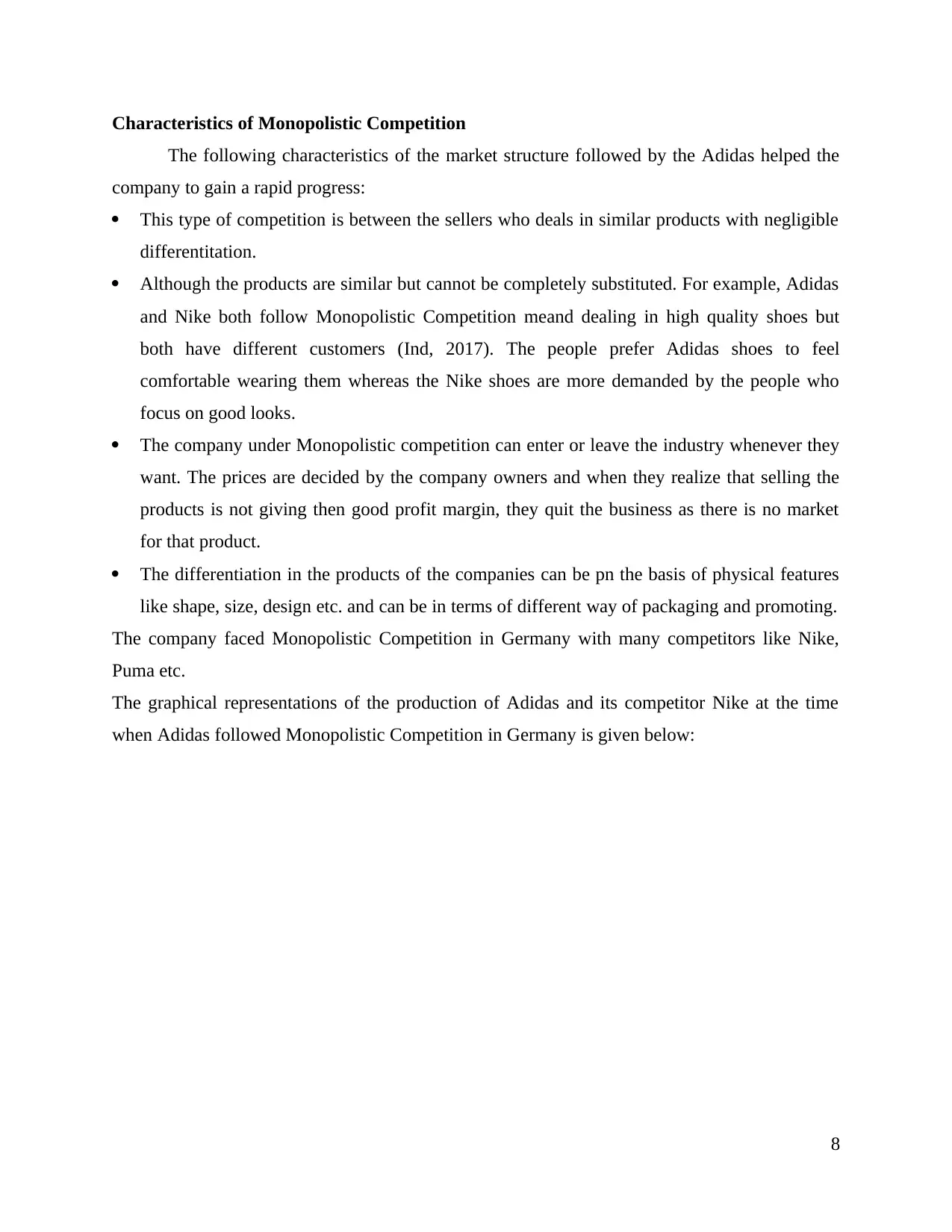
Characteristics of Monopolistic Competition
The following characteristics of the market structure followed by the Adidas helped the
company to gain a rapid progress:
This type of competition is between the sellers who deals in similar products with negligible
differentitation.
Although the products are similar but cannot be completely substituted. For example, Adidas
and Nike both follow Monopolistic Competition meand dealing in high quality shoes but
both have different customers (Ind, 2017). The people prefer Adidas shoes to feel
comfortable wearing them whereas the Nike shoes are more demanded by the people who
focus on good looks.
The company under Monopolistic competition can enter or leave the industry whenever they
want. The prices are decided by the company owners and when they realize that selling the
products is not giving then good profit margin, they quit the business as there is no market
for that product.
The differentiation in the products of the companies can be pn the basis of physical features
like shape, size, design etc. and can be in terms of different way of packaging and promoting.
The company faced Monopolistic Competition in Germany with many competitors like Nike,
Puma etc.
The graphical representations of the production of Adidas and its competitor Nike at the time
when Adidas followed Monopolistic Competition in Germany is given below:
8
The following characteristics of the market structure followed by the Adidas helped the
company to gain a rapid progress:
This type of competition is between the sellers who deals in similar products with negligible
differentitation.
Although the products are similar but cannot be completely substituted. For example, Adidas
and Nike both follow Monopolistic Competition meand dealing in high quality shoes but
both have different customers (Ind, 2017). The people prefer Adidas shoes to feel
comfortable wearing them whereas the Nike shoes are more demanded by the people who
focus on good looks.
The company under Monopolistic competition can enter or leave the industry whenever they
want. The prices are decided by the company owners and when they realize that selling the
products is not giving then good profit margin, they quit the business as there is no market
for that product.
The differentiation in the products of the companies can be pn the basis of physical features
like shape, size, design etc. and can be in terms of different way of packaging and promoting.
The company faced Monopolistic Competition in Germany with many competitors like Nike,
Puma etc.
The graphical representations of the production of Adidas and its competitor Nike at the time
when Adidas followed Monopolistic Competition in Germany is given below:
8
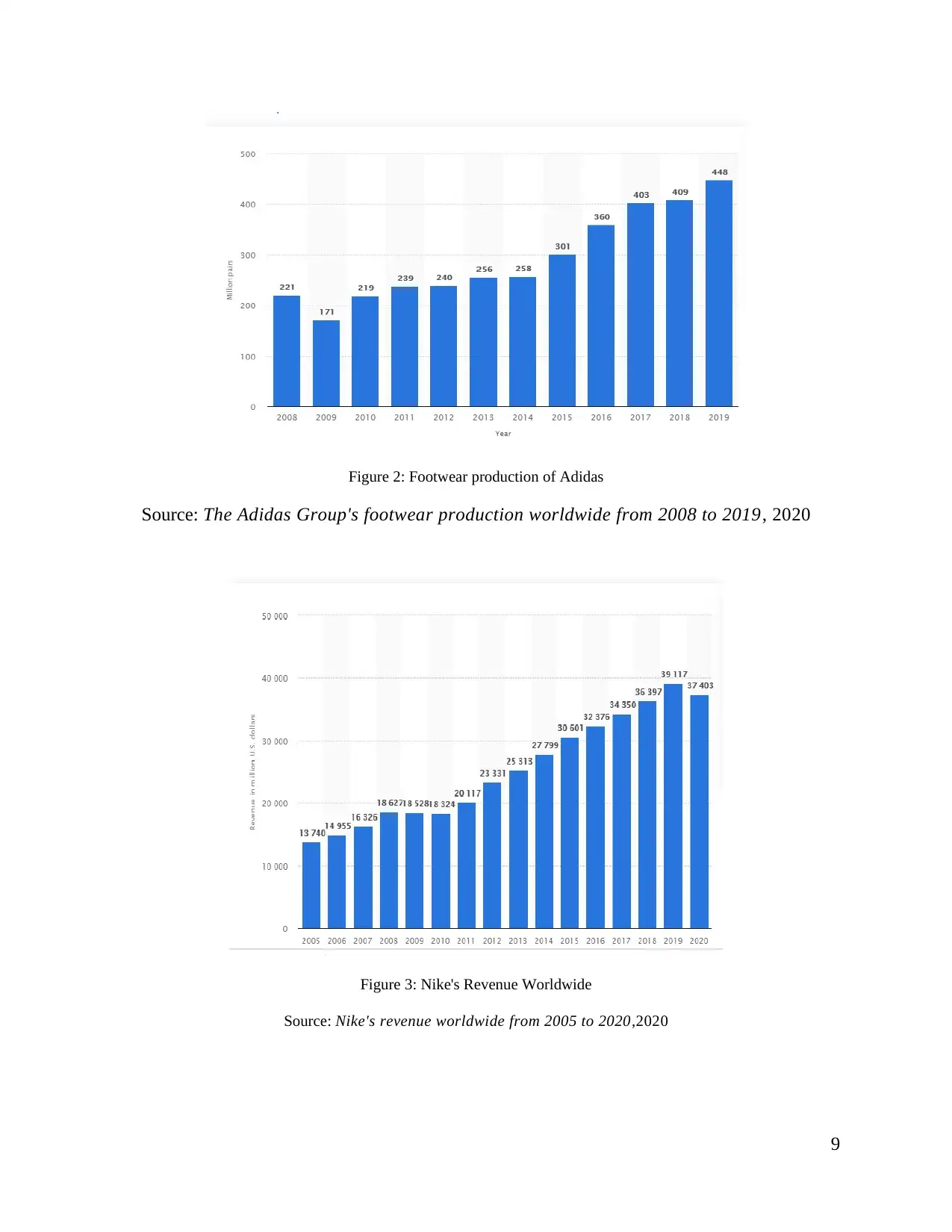
Figure 2: Footwear production of Adidas
Source: The Adidas Group's footwear production worldwide from 2008 to 2019, 2020
Figure 3: Nike's Revenue Worldwide
Source: Nike's revenue worldwide from 2005 to 2020,2020
9
Source: The Adidas Group's footwear production worldwide from 2008 to 2019, 2020
Figure 3: Nike's Revenue Worldwide
Source: Nike's revenue worldwide from 2005 to 2020,2020
9
⊘ This is a preview!⊘
Do you want full access?
Subscribe today to unlock all pages.

Trusted by 1+ million students worldwide

Figure 4: Adidas sales
Source: Net sales of the Adidas brand from 2017 to 2019, by region (in million euros),2020
Although, the Adidas faced a rapid growth in all the areas of the world under Monopolistic
Competition, but in the long run the company faced problems in terms of excess capacity. As the
products of the brand were demanded more day by day, the company produced excess output and
keeping the production’s cost low but after some years there were many options for the
customers to buy similar products like Nike and Puma which increased the competition making it
difficult to sell its products (Neus, Stadler and Unsorg, 2020). The company then planned to
change its market structure.
So, the company planned to perform its operation in Oligopoly market. In this situation, a single
company is controlled by group of various firms. The company faced high market concentration
in order to sell the branded products by more advertising and marketing to gain competitive
advantage. The entry barriers also exist in such kind of markets and competition.
Analysing the Market structure
Oligopoly - A Better Option
10
Source: Net sales of the Adidas brand from 2017 to 2019, by region (in million euros),2020
Although, the Adidas faced a rapid growth in all the areas of the world under Monopolistic
Competition, but in the long run the company faced problems in terms of excess capacity. As the
products of the brand were demanded more day by day, the company produced excess output and
keeping the production’s cost low but after some years there were many options for the
customers to buy similar products like Nike and Puma which increased the competition making it
difficult to sell its products (Neus, Stadler and Unsorg, 2020). The company then planned to
change its market structure.
So, the company planned to perform its operation in Oligopoly market. In this situation, a single
company is controlled by group of various firms. The company faced high market concentration
in order to sell the branded products by more advertising and marketing to gain competitive
advantage. The entry barriers also exist in such kind of markets and competition.
Analysing the Market structure
Oligopoly - A Better Option
10
Paraphrase This Document
Need a fresh take? Get an instant paraphrase of this document with our AI Paraphraser
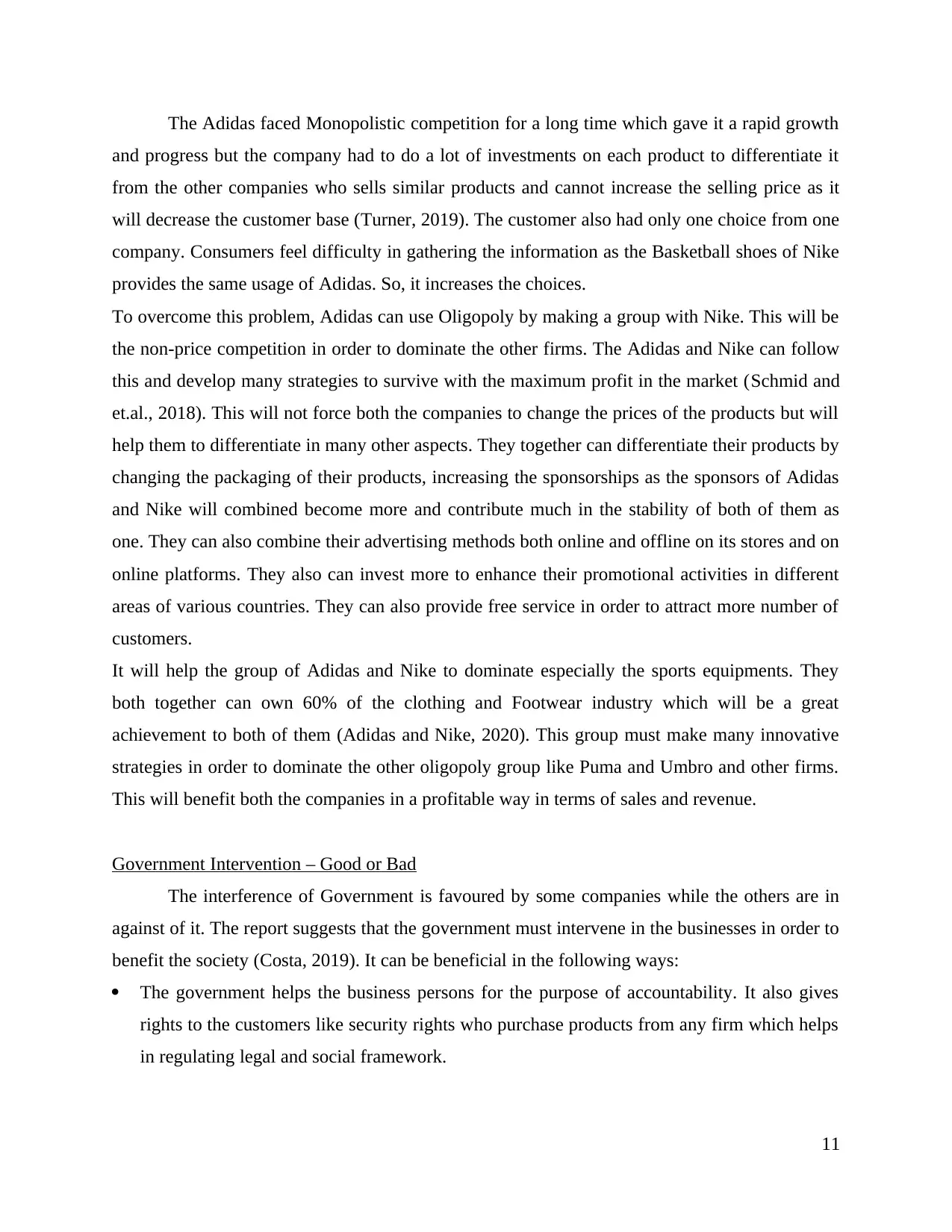
The Adidas faced Monopolistic competition for a long time which gave it a rapid growth
and progress but the company had to do a lot of investments on each product to differentiate it
from the other companies who sells similar products and cannot increase the selling price as it
will decrease the customer base (Turner, 2019). The customer also had only one choice from one
company. Consumers feel difficulty in gathering the information as the Basketball shoes of Nike
provides the same usage of Adidas. So, it increases the choices.
To overcome this problem, Adidas can use Oligopoly by making a group with Nike. This will be
the non-price competition in order to dominate the other firms. The Adidas and Nike can follow
this and develop many strategies to survive with the maximum profit in the market (Schmid and
et.al., 2018). This will not force both the companies to change the prices of the products but will
help them to differentiate in many other aspects. They together can differentiate their products by
changing the packaging of their products, increasing the sponsorships as the sponsors of Adidas
and Nike will combined become more and contribute much in the stability of both of them as
one. They can also combine their advertising methods both online and offline on its stores and on
online platforms. They also can invest more to enhance their promotional activities in different
areas of various countries. They can also provide free service in order to attract more number of
customers.
It will help the group of Adidas and Nike to dominate especially the sports equipments. They
both together can own 60% of the clothing and Footwear industry which will be a great
achievement to both of them (Adidas and Nike, 2020). This group must make many innovative
strategies in order to dominate the other oligopoly group like Puma and Umbro and other firms.
This will benefit both the companies in a profitable way in terms of sales and revenue.
Government Intervention – Good or Bad
The interference of Government is favoured by some companies while the others are in
against of it. The report suggests that the government must intervene in the businesses in order to
benefit the society (Costa, 2019). It can be beneficial in the following ways:
The government helps the business persons for the purpose of accountability. It also gives
rights to the customers like security rights who purchase products from any firm which helps
in regulating legal and social framework.
11
and progress but the company had to do a lot of investments on each product to differentiate it
from the other companies who sells similar products and cannot increase the selling price as it
will decrease the customer base (Turner, 2019). The customer also had only one choice from one
company. Consumers feel difficulty in gathering the information as the Basketball shoes of Nike
provides the same usage of Adidas. So, it increases the choices.
To overcome this problem, Adidas can use Oligopoly by making a group with Nike. This will be
the non-price competition in order to dominate the other firms. The Adidas and Nike can follow
this and develop many strategies to survive with the maximum profit in the market (Schmid and
et.al., 2018). This will not force both the companies to change the prices of the products but will
help them to differentiate in many other aspects. They together can differentiate their products by
changing the packaging of their products, increasing the sponsorships as the sponsors of Adidas
and Nike will combined become more and contribute much in the stability of both of them as
one. They can also combine their advertising methods both online and offline on its stores and on
online platforms. They also can invest more to enhance their promotional activities in different
areas of various countries. They can also provide free service in order to attract more number of
customers.
It will help the group of Adidas and Nike to dominate especially the sports equipments. They
both together can own 60% of the clothing and Footwear industry which will be a great
achievement to both of them (Adidas and Nike, 2020). This group must make many innovative
strategies in order to dominate the other oligopoly group like Puma and Umbro and other firms.
This will benefit both the companies in a profitable way in terms of sales and revenue.
Government Intervention – Good or Bad
The interference of Government is favoured by some companies while the others are in
against of it. The report suggests that the government must intervene in the businesses in order to
benefit the society (Costa, 2019). It can be beneficial in the following ways:
The government helps the business persons for the purpose of accountability. It also gives
rights to the customers like security rights who purchase products from any firm which helps
in regulating legal and social framework.
11
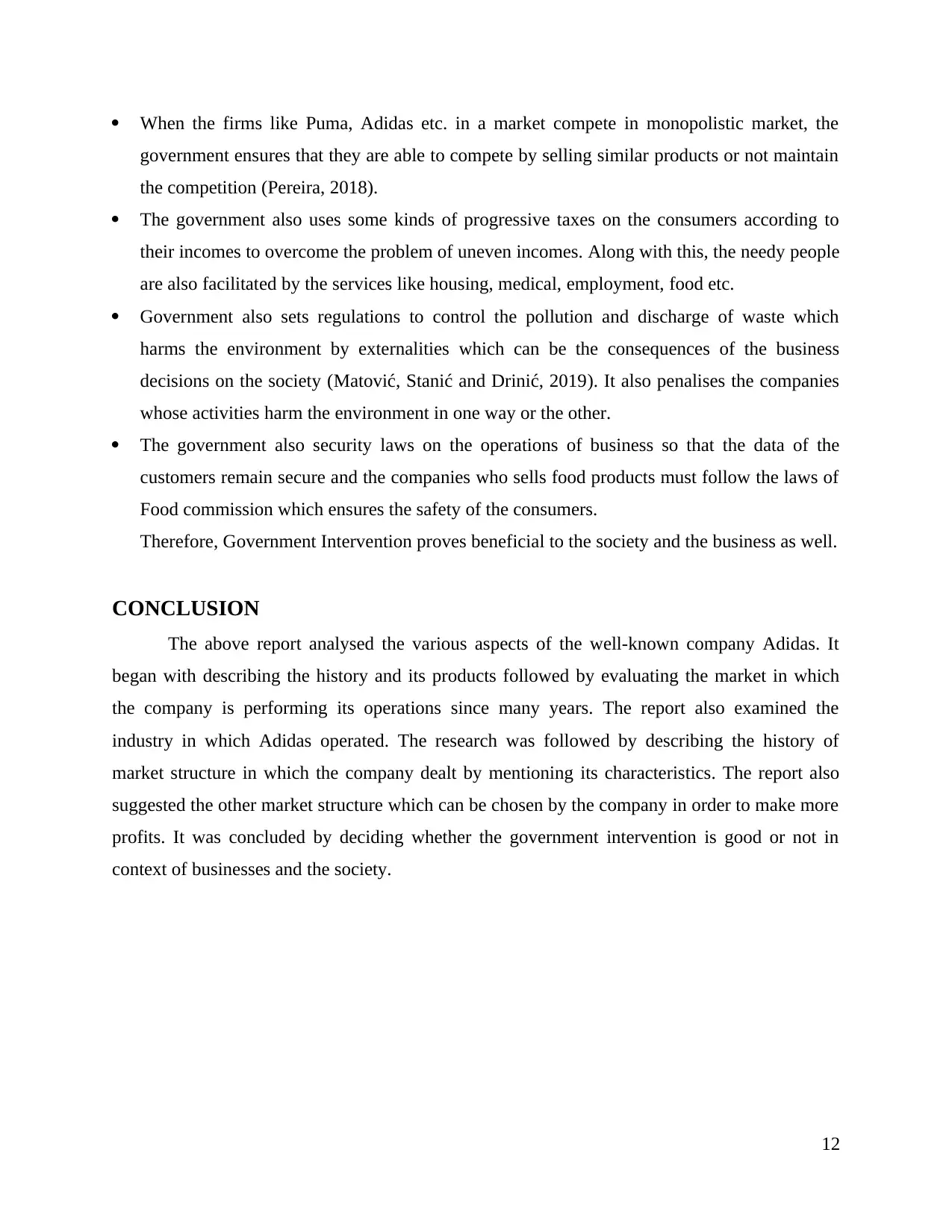
When the firms like Puma, Adidas etc. in a market compete in monopolistic market, the
government ensures that they are able to compete by selling similar products or not maintain
the competition (Pereira, 2018).
The government also uses some kinds of progressive taxes on the consumers according to
their incomes to overcome the problem of uneven incomes. Along with this, the needy people
are also facilitated by the services like housing, medical, employment, food etc.
Government also sets regulations to control the pollution and discharge of waste which
harms the environment by externalities which can be the consequences of the business
decisions on the society (Matović, Stanić and Drinić, 2019). It also penalises the companies
whose activities harm the environment in one way or the other.
The government also security laws on the operations of business so that the data of the
customers remain secure and the companies who sells food products must follow the laws of
Food commission which ensures the safety of the consumers.
Therefore, Government Intervention proves beneficial to the society and the business as well.
CONCLUSION
The above report analysed the various aspects of the well-known company Adidas. It
began with describing the history and its products followed by evaluating the market in which
the company is performing its operations since many years. The report also examined the
industry in which Adidas operated. The research was followed by describing the history of
market structure in which the company dealt by mentioning its characteristics. The report also
suggested the other market structure which can be chosen by the company in order to make more
profits. It was concluded by deciding whether the government intervention is good or not in
context of businesses and the society.
12
government ensures that they are able to compete by selling similar products or not maintain
the competition (Pereira, 2018).
The government also uses some kinds of progressive taxes on the consumers according to
their incomes to overcome the problem of uneven incomes. Along with this, the needy people
are also facilitated by the services like housing, medical, employment, food etc.
Government also sets regulations to control the pollution and discharge of waste which
harms the environment by externalities which can be the consequences of the business
decisions on the society (Matović, Stanić and Drinić, 2019). It also penalises the companies
whose activities harm the environment in one way or the other.
The government also security laws on the operations of business so that the data of the
customers remain secure and the companies who sells food products must follow the laws of
Food commission which ensures the safety of the consumers.
Therefore, Government Intervention proves beneficial to the society and the business as well.
CONCLUSION
The above report analysed the various aspects of the well-known company Adidas. It
began with describing the history and its products followed by evaluating the market in which
the company is performing its operations since many years. The report also examined the
industry in which Adidas operated. The research was followed by describing the history of
market structure in which the company dealt by mentioning its characteristics. The report also
suggested the other market structure which can be chosen by the company in order to make more
profits. It was concluded by deciding whether the government intervention is good or not in
context of businesses and the society.
12
⊘ This is a preview!⊘
Do you want full access?
Subscribe today to unlock all pages.

Trusted by 1+ million students worldwide
1 out of 13
Related Documents
Your All-in-One AI-Powered Toolkit for Academic Success.
+13062052269
info@desklib.com
Available 24*7 on WhatsApp / Email
![[object Object]](/_next/static/media/star-bottom.7253800d.svg)
Unlock your academic potential
Copyright © 2020–2025 A2Z Services. All Rights Reserved. Developed and managed by ZUCOL.





